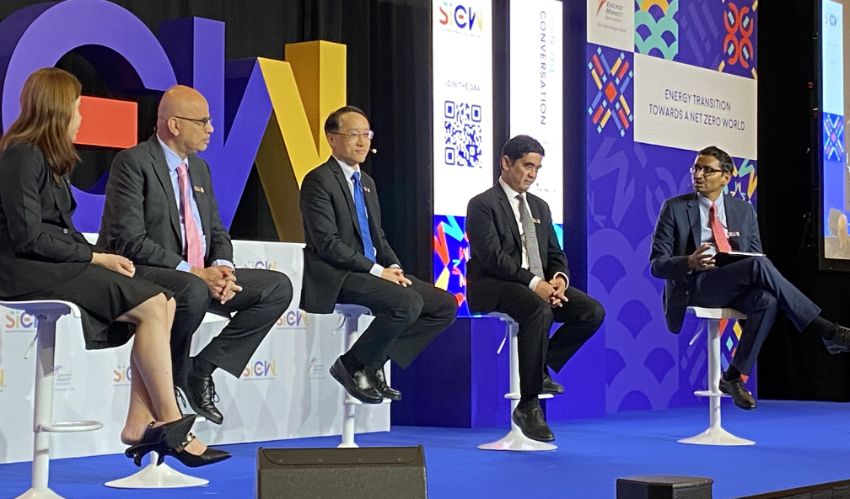Insights from energy sector leaders on regional interconnection. Anthony Cebokli, Associate, Infrastructure Advisory - Deal Advisory, KPMG Services Pte Ltd Singapore, reports. This article is contributed by KPMG - the official Content Partner for SIEW 2023.

In this panel discussion, experts from the energy sector explored the importance of regional connectivity in achieving energy security, affordability, and sustainability. They highlighted the historical significance of interconnected power systems and discussed the potential for regional grids to enhance energy security and catalyse development of renewable energy. The speakers emphasised the need for high-level government commitment, technological advancements, and collaboration among various stakeholders to make regional connectivity a reality.
Mutual regional support enhances energy security and feasibility
Ngiam Shih Chun, Chief Executive of the Energy Market Authority of Singapore (EMA), shed light on the pivotal significance of regional connectivity.
Drawing compelling parallels between the evolution of interconnected domestic power systems and the transformative potential of regional grids, he underlined their ability to enhance energy security, reduce costs, and accelerate the adoption of renewable energy sources. Regional grids, founded on the concept of mutual support, not only provide a more stable and reliable power system but also yield significant cost savings by efficiently sharing reserves. The LTMS (Laos-Thailand-Malaysia-Singapore Power Integration Project) serves as a real-world example of how such cross-border collaboration can be effectively implemented.
“There's no reason why countries can't be interconnected the same way that cities and towns are today interconnected within the same country’’ said Mr Nigam.
"I believe we are all converging on the point that regional connectivity can help catalyse renewable energy generation as well as make energy more affordable across the region. The challenge now is to make it happen," said Anish De, Global Head of Energy, Natural Resources and Chemicals of KPMG in India.
Affordability and clean energy adoption
Tuan Mohammed Rashdan bin Mohd Yusof, Chairman of the Energy Commission in Malaysia, highlighted the economic and environmental advantages of regional connectivity.
By mitigating the need for high reserve margins, regional grids make energy more affordable. They also serve as a catalyst for greener, cleaner energy solutions, fostering sustainability and cost-effectiveness. This transition towards renewable sources not only reduces costs but also paves the way for a more sustainable and eco-friendly energy landscape. Mr Rashdan also alluded to the significant benefits observed in Europe, where interconnected energy markets have thrived, offering valuable lessons for the ASEAN region.
‘’I believe one area that we need to look at is to establish a common national energy market, allowing electrons to flow freely, as dictated by market forces," said Mr Rashdan.
Rajat Misra, Director General, Infrastructure Investment Department (Region 1), Asian Infrastructure Investment Bank, emphasised the importance of regional connectivity in bringing diverse markets closer together. He highlighted the role of multilaterals in facilitating cooperation among countries, optimising resource use, and fostering cross-border electricity trade.
The private sector's crucial role
Janice Bong, Managing Director, Power & Renewables at Keppel Infrastructure, highlighted the vital role of private companies in advancing clean energy. She underscored the opportunities of regional connectivity in achieving sustainability and generating investments. Ms Bong emphasised the need for large-scale renewable projects but noted the critical role of supportive government regulations.
She also discussed challenges such as grid congestion and subsea cable usage. According to Ms Bong, cost considerations, risk allocation, and bankability are essential for project success. Keppel collaborated with regulators to develop structures that align with policies and promote efficient electron transmission. In short, private sector involvement, regional connectivity, and addressing key challenges are central to advancing clean energy.
“By working closely with our partners and regulators upstream, and understanding how commercial structures can align with government policies, we allow electrons to flow seamlessly from the source country to the import country,’’ said Miss Bong.
In summary, the discussion on regional connectivity centred around its potential to enhance energy security, reduce costs, and accelerate the adoption of renewable energy sources. By connecting countries and regions, regional connectivity facilitates the efficient sharing of green energy resources, paving the way for a more sustainable and eco-friendly energy landscape. Participation from the private sector as well as the is crucial in driving the decarbonisation of energy and leveraging these opportunities. As we move towards a net zero world, regional connectivity acts as a catalyst, bridging the gap between nations that are resource-rich and those that are energy-hungry, and propelling the transition to cleaner and more sustainable energy sources.
Follow us for more timely updates on X (formerly Twitter) and Telegram.